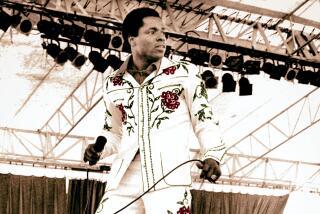Edward Kean dies at 85; head writer for ‘The Howdy Doody Show’
- Share via
Edward Kean, the original head writer for “The Howdy Doody Show,” the pioneer NBC children’s TV program for which he also created characters and wrote the songs, has died. He was 85.
Kean died Aug. 13 of complications of emphysema at a health-care center in West Bloomfield, Mich., said family friend Del Reddy.
“Say, kids, what time is it?” host Buffalo Bob Smith would shout at the start of each show, which starred the famous freckle-faced boy marionette clad in cowboy duds.
“It’s Howdy Doody Time!” the children in the studio’s “Peanut Gallery” would respond.
Initially launched as “Puppet Playhouse” in December 1947 and renamed “The Howdy Doody Show” some months later, the program featured an array of costumed human characters and marionettes.
Smith was a well-known New York City radio disc jockey when he hired Kean, a World War II Navy veteran, to write material for Smith’s radio show.
They went on to make TV history with “The Howdy Doody Show,” for which Kean also wrote the “It’s Howdy Doody Time” theme song.
“Eddie Kean invented ‘Howdy Doody,’ basically,” said Stephen Davis, author of the 1987 book “Say Kids! What Time Is It?”
“He came up with the story lines and the characters, and the characters became national icons — chiefly because there was nothing else on; they had no competition,” Davis said.
The show became an overnight sensation that launched a blitz of Howdy Doody merchandise and sponsor tie-ins.
“They did a half-hour a day of live TV five days a week,” Davis said. “It went on at 5:30, and it caught on because the mothers would turn on the TV and could make dinner without being bothered by the kids, who were glued to the ‘The Howdy Doody Show.’ ”
One of the show’s most famous characters was the mute Clarabell the Clown, who honked a horn to communicate and sprayed everyone with a seltzer bottle. (Clarabell originally was played by Bob Keeshan, TV’s future Captain Kangaroo.)
Other Doodyville characters included Mayor Phineas T. Bluster, Dilly Dally and Flub-a Dub.
“I feel ridiculous telling you these things with a straight face,” Kean said in a 1987 interview with the Miami Herald. “But this is the real me. I had the most ridiculous sense of humor. I hadn’t grown up myself.
“If I had to take a bow, it was for having a knack rather than an art, a knack for knowing what kids would go for.”
Kean also came up with the word “cowabunga” for the show, although he spelled it “kowabonga.”
“On ‘Howdy,’ we had a character named Chief Thunderthud,” Kean recalled in a 1997 interview with the Chicago Tribune, “and Buffalo Bob Smith rightly thought the old boy needed his own greeting. Movie Indians said, ‘How!’ in those days, you know, but I always felt ‘How’ sounded stupid and contrived.
“Our Princess Summerfall Winterspring used kowagoopa as her greeting, so kowabonga seemed logical enough for Chief Thunderthud.”
Smith, in the same Tribune story, recalled Kean as being “a creative genius with a marvelous sixth sense for knowing what kids would enjoy. Only Eddie Kean could have come up with kowabonga ... and believe me, kowabonga caught on!”
The full line, Kean recalled, “went ‘Kowabonga, Buffalo Bob!’ Later, I had the chief use kowabonga as a mild curse in his fights with Clarabell. Knowabonga meant ‘hell’ or ‘darn it!’ My preferred spelling was kowabonga, but I see where the surfers changed it to cowabunga.”
“The Howdy Doody Show” ran until 1960, but Kean left the program in the mid-1950s.
“Eddie was really burned out doing five live half-hours a week, and even the commercials had to be scripted,” Davis said.
Kean, who was born in New York City on Oct. 28, 1924, had degrees from Columbia and Cornell universities. After leaving “The Howdy Doody Show,” he worked as a stockbroker and in public relations.
He also wrote for one of Merv Griffin’s TV shows and wrote a newspaper column called the Consumer Madvocate for a number of years.
“On the side, he played beautiful piano,” said Kean’s wife, Vivian, noting that he played in hotels and restaurants in Coral Gables, Fla. And after moving to Michigan in the mid-1990s, Kean continued to play piano in similar venues until recently.
In addition to Vivian, his third wife, Kean is survived by his son, Edward Jr.; his stepchildren, Scott Smith and Cynthia Benjamin; three grandchildren; and four step-grandchildren.
dennis.mclellan@latimes.com
More to Read
Start your day right
Sign up for Essential California for the L.A. Times biggest news, features and recommendations in your inbox six days a week.
You may occasionally receive promotional content from the Los Angeles Times.






